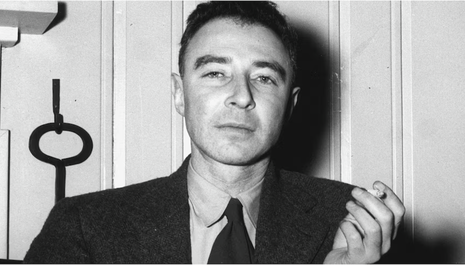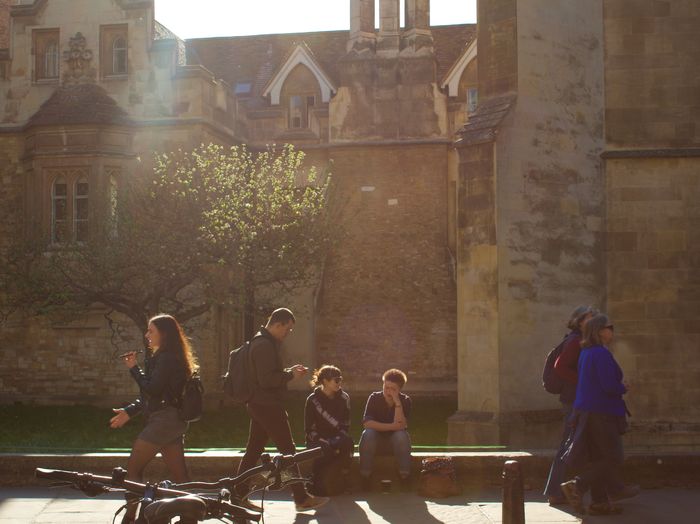Oppenheimer in Cambridge: The father of the atomic bomb who tried to poison his supervisor
Suchir Salhan uncovers the truth about Oppenheimer’s time at Cambridge during the 1920s

In 1925, a depressed American physicist completing a year of graduate study in Cambridge dosed an apple with poisonous chemicals and placed it on his supervisor’s desk.
This young student was Robert Oppenheimer, the hat-wearing, chain-smoking Manhattan Project scientist behind the atomic bomb. In light of the release of Christopher Nolan’s biographical thriller of the enigmatic scientist (in what some cinemagoers have dubbed “Barbenheimer”, a consequence of the simultaneously screening Barbie film), the true story of Oppenheimer’s time in Cambridge was much bleaker than you’d perhaps expect.
“I am having a pretty bad time”, begins the third chapter of Bird & Sherwin’s (2005) biography American Prometheus: The Triumph and Tragedy of J. Robert Oppenheimer, which Nolan’s film is based on. It refers to a letter that Oppenheimer wrote to his close friend Francis Fergusson about his time in the Cavendish, where he said: “I’m having a pretty bad time. The lab work here is a terrible bore, and I am so bad at it that it is impossible to feel that I am learning anything … the lectures are vile.”
Oppenheimer was given an offer to study at Christ’s College in 1924, aged 21, and wrote to “the father of nuclear physics”, Ernest Rutherford, to request to work at the Cavendish. His clumsiness in the lab did not impress Rutherford. He was accepted by the man who discovered the electron, JJ Thomson, on the precondition that he completed an introductory lab course. He spent only a year in the University after graduating from Harvard. Rutherford was suspicious of Oppenheimer and refused to work with him: “Rutherford wouldn’t have me. My credentials were peculiar and not impressive.” The rejection set the tone for Oppenheimer’s tumultuous stint in Cambridge.
In March 1926, he took a holiday in Corsica with three friends from Harvard for 10 days. “Dostoyevsky is superior,” Oppenheimer insisted one night, as they got caught up in a storm ducking into an inn after days spent indulging in decadent food and wine. He told his friends that he strongly identified with the unhappy protagonist of Crime and Punishment, Raskolnikov, who was tormented by guilt which drove him to confess to an unsolved murder: “He gets to the soul and torment of man.”
That holiday he was especially agitated, unusually so for what his friends described as an already “fidgety” man. Oppenheimer developed close friends in Cambridge: in one incident, Francis Fergusson tried to “distract” Oppenheimer from his depression, telling him he was about to marry his girlfriend. Oppenheimer jumped on Fergusson and tried to suffocate him. Fergusson recounted the “poisoned apple” episode which Oppenheimer confessed to at the end of the Corsica trip, suddenly announcing that he had to return to England because he’d done a “terrible thing”.
“The tense relationship with his supervisor formed a pivotal part of his Cambridge experience”
Oppenheimer had a tense relationship with his supervisor Patrick Blackett. One historian suggested: “Blackett was handsome, suave and highly skilled as an experimenter – everything Oppenheimer wanted to be.” While the film only touches upon Oppenheimer’s relationship with Blackett and includes a fleeting cameo of King’s backs, the tense relationship with his supervisor formed a pivotal part of his Cambridge experience.
Oppenheimer’s desire to study theoretical physics – rather than do lab work – brought him into conflict with Blackett, whose supervisions were so demanding that it brought Oppenheimer to near-psychiatric breakdown. Bird & Sherwin describe how “one day Robert caught himself staring at an empty blackboard with a piece of chalk in his hand, muttering over and over, ‘The point is ... The point is ... The point is ...’” Blackett didn’t eat the poisonous apple but, somehow, University authorities were informed.
The incident led Cambridge to threaten to place criminal charges on Oppenheimer, though this did not progress after pleas from his parents. His wealthy father just happened to be visiting Cambridge that week. Instead, he was ordered to go to London for regular sessions with a psychiatrist, where he was diagnosed with symptoms associated with schizophrenia.
The Freudian psychoanalyst who treated him described Oppenheimer as a “hopeless case”. University dons likely would not extend such leniency these days. The whole scandal was muddied by conflicting stories. A more complicated failure in research was the root of Oppenheimer’s psychological turmoil in Cambridge. John Edsall, a peer at Harvard and later at Cambridge University, suggested that Oppenheimer’s “tremendous admiration, combined perhaps with an intense jealousy” towards his supervisor contributed to his personal struggles in the University. Both scientists ultimately went their separate ways.
“A more complicated failure in research was the root of Oppenheimer’s psychological turmoil in Cambridge”
Yet, it was not all doom and gloom in Cambridge. Oppenheimer wrote to Fergusson in November 1925 that Cambridge “is very rich and has plenty of luscious treasures … I have been taken to all sorts of meetings: High Maths at Trinity, a secret pacifist meeting, a Zionist meeting and several rather pallid science clubs.” After returning to the University after Corsica, he moved to “less miserable quarters … halfway to Grantchester”. Europe and Cambridge provided an unbeatable nexus for Oppenheimer to meet the great physicists of the 1920s. “When Rutherford introduced me to Bohr, he asked me what I was working on. I told him and he said, ‘How is it going?’ I said ‘I’m in difficulties.’ He said ‘Are the difficulties mathematical or physical?’ I said ‘I don’t know’. He said ‘That’s bad,’” recounted Oppenheimer.
The encounter ended up the first of his two research papers published in Cambridge. Oppenheimer’s later recollections of his time in Cambridge may be somewhat exaggerated. “I hadn’t been good, I hadn’t done anybody any good, and I hadn’t had any fun whatsoever ... I was on the point of bumping myself off,” he recounted two decades later. However, Edsall recalled in a 1975 interview that Oppenheimer avidly followed the latest developments in quantum theory and “it became very obvious, that he was terribly eager to really get in on this and make a major contribution of his own [and] felt the strong urge to be the one who did accomplish things.”
Oppenheimer’s sojourn in Cambridge proved to be a disaster in many ways. His mental health improved after the “poisoned apple” episode and his friends described him as “much more serene” after leaving Cambridge, with a newfound sense of confidence and authority. Oppenheimer swiftly moved on to Göttingen to work with quantum physicist Niels Bohr. Unlike Dostoyevsky’s protagonist, Oppenheimer’s science was yet to kill someone in his time at Cambridge – he had to wait until Hiroshima for that. And the rest is history.
 News / Cambridge academics stand out in King’s 2026 Honours List2 January 2026
News / Cambridge academics stand out in King’s 2026 Honours List2 January 2026 Interviews / You don’t need to peak at Cambridge, says Robin Harding31 December 2025
Interviews / You don’t need to peak at Cambridge, says Robin Harding31 December 2025 Comment / What happened to men at Cambridge?31 December 2025
Comment / What happened to men at Cambridge?31 December 2025 News / Varsity’s biggest stories of 202531 December 2025
News / Varsity’s biggest stories of 202531 December 2025 Features / “It’s a momentary expression of rage”: reforming democracy from Cambridge4 January 2026
Features / “It’s a momentary expression of rage”: reforming democracy from Cambridge4 January 2026










